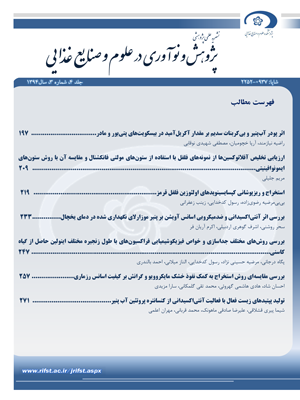استاندارد ملی ایران. 1385. کیک- ویژگیها و روشهای آزمون. شماره 2553. تجدید نظر سوم.
استاندارد ملی ایران. 1387. پنیر و فرآوردههای آن- پودر آب پنیر- ویژگیها و روشهای آزمون. شماره 6959، تجدید نظر اول.
استاندارد ملی ایران. 1388. بیسکویت- ویژگیها و روشهای آزمون. شماره 37. تجدید نظر ششم.رجب زاده، ن. 1386. مبانی فناوری غلات. جلد دوم. نوبت چاپ دوم. انتشارات دانشگاه تهران. 572 صفحه.
Amrein, T.M., Schonbachler, B., Escher, F. & Amado, R. 2004. Acrylamide in gingerbread: critical factors for formation and possible ways for reduction. Journal of Agricultural and Food Chemistry, 52: 4282- 4288.
Arribas-Lorenzo, G. Fogliano, V. & Morales, F. J. 2009. Acrylamide formation in a cookie system as influenced by the oil phenol profile and degree of oxidation. European Food Research Technology, 229: 63–72.
Biedermann, M., Biedermann-Berm, S. & Noti, A. 2002. Two GC-MS methods for the analysis of acrylamide in foodstuffs. Mitteilungen aus Lebensmitteluntersuchung und Hygiene, 93: 638- 652.
Boroushaki, M.T., Nikkhah, E., Kazemi, A., Oskooei, M. & Raters, M. 2010. Determination of acrylamide level in popular Iranian brands of potato and corn products. Food and Chemical Toxocology, 10: 2581- 2584.
Claus, A., Carle, R. & Schieber, A. 2008. Acrylamide in cereal products: a review. Journal of Cereal Science, 47: 118–133.
Claus, A., Mongili, M., Weisz, G., Schieber, A. & Carle, R. 2008. Impact of formulation and technological factors on the acrylamide content of wheat bread and bread rolls. Journal of Cereal Science, 47: 546- 554.
Codex alimentarius, 2003. Discussion paper on acrylamide. Available from: http://www.codexalimentarius.com/CX/FAC 04/36/34, Rotterdam, Netherlands.
EL-Saied, M.H., Sharaf, A.M., Abul-Fadl M.M. & EL-Badry, N. 2008. Reduction of acrylamide formation in fried potato strips by different pre-frying treatments. World Journal of Dairy & Food Sciences 3 (1): 17-24.
Erdogdu, S. B., Palazoglu, T. K., Gokmen, V., Senyuva, H. Z. & Ekiz. H. I. 2007. Reduction of acrylamide formation in French fries by microwave pre-cooking of potato strips. Journal of the Science of Food and Agriculture, 87: 133–137.
Friedman, M. & Levin, C.E. 2008. Review of methods for the reduction of dietary content and toxicity of acrylamide. Journal of Agricultural and Food Chemistry, 56: 6113- 6140.
Graf, M., Amrein, T.M., Graf, S., Szalay, R., Escher, F., & Amado, R. 2006. Reducing the acrylamide content of a semi-finished biscuit on industrial scale. LWT, 39: 724- 728
Granda, C. 2005. Kinetics of acrylamide formation in potato chips. Journal of Biological and Agricultural Engineering, 92: 78- 82.
Hollnagel, A., & Kroh, L.W. 1998. Formation of R-dicarbonyl fragments from mono and disaccharides under caramelization and Maillard reaction conditions. Z Lebensm. Unters. Forsch. As Food Research Technology, 207: 50- 54.
Keramat, J., Lebali, A., Prost, C., & Jafari, M. 2011. Acrylamid in baking products: Journal of Food Bioprocess Technology, 4: 530- 543.
Ledl, F., & Schleicher, E. 1990. New aspects of the Maillard reaction in foods and in the human body. Angewandte Chemie International Edition in English, 29 (6): 565- 594.
Mavropoulou, I.P., & Kosikowski, F.V. 1972. Composition, solubility, and stability of whey powders. Journal of Dairy Science, 56: 1128- 1134.
Mustafa, A. 2008, Acrylamide in Bread Precursors, Formation and Reduction. Doctoral thesis, Swedish University of Agricultural Sciences. Uppsala. Sweden.
Ou, S., Shi, J., Huang, C., Zhang, G., Teng, J., Jiang, Y. & Yang B. 2010. Effect of antioxidants on elimination and formation of acrylamide in model reaction systems. Journal of Hazardous Materials, 182: 863–868.
Parzefall, W. 2008. Mini-review of toxicity of dietary acrylamide. Food and Chemical Toxicology, 46: 1360- 1364.
Pedreschi, F. Kaack, K. & Granby, K. 2008. The effect of asparaginase on acrylamide formation in French fries. Food Chemistry, 109 (2): 386–392.
Pedreschi, F., Granby K. & Risum, J. 2010. Acrylamide mitigation in potato chips by using NaCl. Food Bioprocess Technology, 3: 917–921.
Piloty, M. & Baltes, W. 1979. Investigations on the reaction of amino acids with R-dicarbonyl compounds. 1. Reactivity of amino acids in the reaction with R-dicarbonyl compounds (in German). Z. Lebensm.-Unters.-Forsch, 168: 368- 373.
Salazar, R., Arambula-Villa, G., Vazquez-Landaverde, P.A., Hidalgo, F. & Zamora, R. 2012. Mitigating effect of Amaranth (Amarantus hypochondriacus) protein on acrylamide formation in foods. Food Chemistry, 135: 2293- 2298.
Sirot V., Hommet, F., Tard, A. & Leblanc, J. 2012. Dietary acrylamide exposure of the French population: results of the Second French Total Diet Study, Food and Chemical Toxicology, 50 (3-4): 889–894.
Watt, B.K. & Merill, A.L. 1963. Composition of foods. Raw, processed, prepared. U.S. Deptartment of Agriculture. Agricultural handbook. No. 8. 190 pp.
 پژوهش و نوآوری در علوم و صنایع غذایی
پژوهش و نوآوری در علوم و صنایع غذایی

ارسال نظر در مورد این مقاله